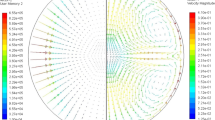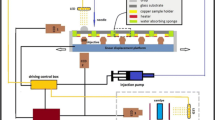Summary
The virtual absence of hydrostatic pressure in a microgravity environment allows liquids to be confined solely by their surface tension and offers the possibility of melting and solidifying materials without physical contact. This “containerless processing” eliminates contaminants that may be introduced by the container or crucible and may be used to obtain ultrapure materials. This is especially important for systems that are highly corrosive in the melt. Elimination of container-induced nucleation also permits melts to be deeply undercooled before solidification. This offers the possibility of studying homogeneous nucleation and solidification in undercooled melts. Such solidification can be extremely rapid and may produce unique microstructures including metastable or amorphous phases in metals. The range of glass formation may be extended in borderline glass forming systems, which may result in new glasses with unusual properties. Since such glasses are formed from melts confined only by surface tension, they will have perfectly spherical pristine surfaces, undamaged by grinding or other shaping processes. It may also be possible to manipulate the melt to form aspherical shapes, or to draw optical fibers from a containerless melt.
The dynamics of drops and bubbles may also be studied using containerless techniques. Detailed photographs of droplets merging were obtained in a simple demonstration on Skylab. The drop dynamics module on Spacelab 3 is dedicated to a more elaborate set of experiments to study the vibrational and rotational behavior of liquid droplets. The centering forces on a bubble suspended in a droplet have also been investigated in a variety of low-gravity experiments to the point where the role of droplet oscillations are understood well enough to permit the routine formation of thin-walled spherical shells up to a few millimeters in diameter that have a high degree of concentricity. Such shells have been used for fuel containment in inertially confined fusion experiments [1] and are also finding a variety of other uses. Finally, the ability to suspend a high temperature melt without physical contact is useful for measurement of high temperature thermophysical properties. Techniques hate been developed for independent measurement of emissivity as a function lof temperature which permits the determination of heat capacity, enthalpy, heat of fusion, etc. for metals such as W, Mo, Nb, and other refractory materials. [2] Surface tension and viscosity may also be determined without physical contact in low to moderate viscosity samples by inducing oscillations in the melt and observing their period and decay, or in high viscosity material by rotating of the sample and measuring the distortion that results. [3]
There are a variety of techniques for containerless processing that can be used to some degree in Earth’s gravity. These techniques consist of suspending or levitating a specimen using non-contacting forces such as gas pressure from an acoustic field or air stream, or electric forces from an electrostatic or electromagnetic field. Such techniques are limited to small samples in Earth’s gravity because the hydrostatic pressure must be confined by surface tension, and distortions from sphericity are unavoidable. Also, the heating and cooling of the sample is generally not independent of the levitation process. Free-fall facilities such as Marshall Space Flight Center’s (MSFC) drop tube and Jet Propulsion Laboratory’s (JPL) aerodynamic drop facility avoid this difficulty, but the limited free-fall distance restricts the sample to a size that can be solidified in the time available. Nevertheless, these techniques have produced much valuable information on containerless processing technology and serve as an indispensible adjunct to microgravity experiments for testing new concepts, screening prospective sample materials, and developing experimental protocol.
The use of the microgravity environment of an orbiting vehicle extends the free-fall time more or less indefinitely and allows much larger samples to be processed as well as close observation and manipulation of the sample during processing. However, the small residual accelerations in an orbiting vehicle require the use of some form of non-contacting positioning force, similar to that used to levitate samples in Earth’s gravity, to hold the sample in the confines of its processing chamber for extended periods of time.
The techniques and facilities for containerless processing, both in space and on Earth, will be described in the remainder of this chapter.
Access this chapter
Tax calculation will be finalised at checkout
Purchases are for personal use only
Preview
Unable to display preview. Download preview PDF.
Similar content being viewed by others
References
Lee, M.C. et. al.: Application of microgravity and containerless envrionments to the investigation of fusion target fabrication technology. Materials Processing in the Reduced Gravity Environment of Space 9 (1982) 95 (G. E. Rindone, ed.), Amsterdam: Elsevier Science Publishing Co.
Margrave J. L.: Heat capacities of liquid metals above 4500 K. Materials Processing in the Reduced Gravity Environment of Space 9 (1982) 39 (G.E. Rindone, ed.), Amsterdam: Elsevier Science Publishing Co.
Trinh, E.; Wang, T.G.: Large-amplitude free and driven drop-shape oscillations: Experimental observations. J. Fluid Mech. 122 (1982) 315.
Lacy, L.L.; Robinson, M.B.; Rathz, T.J.: Containerless undercooling and solidification in drop tubes. J. Crystal Growth 51 (1981) 47–60.
Steinberg, J.; Lord, A.E.; Lacy, L.L.; Johnson, J.: Production of bulk amorphous Pb 77 5 Si 15 5 Cu 6 in a containerless low-gravity environment. Appl. Phys. Letters 38 (1981) 135–137.
Lacy, L.L.; Rathz, T.J.; Robinson, M.B.: Containerless undercooling and solidification of bulk metastable Nb3Ge alloys. J. Appl. Phys. 53 (1982) 682–689.
Collings, E.W.: Magnetic studies of rapidly quenched stainless steel alloys. Cryogenic Materials and Their Welding, Proceedings of the International Cryogenic Materials Conference, Kiev, USSR, July 1984.
Ethridge, E.C.; Curreri, P.A.; Kelley, M.: Results of the technical exchange agreement between NASA and DuPont on the containerless drop tube solidification of NiAl3. NASA TM-86473, October 1984.
Lee, M.C.; Feng, I.; Elleman, D.D.; Wang, T.G.; Young, A.T.: Generation of a strong core-centering force: Submi11imeter compound droplet system. Proceedings of Second International Colloquium on Drops and Bubbles, JPL Publication 82–7 (November 1981) 107.
Kendall, J.M.; Lee, M.C.: Wang, T.G.: Metal shell technology based on hollow jet instability. J. Vac. Sci. Tech. 20 (1982) 1091.
Lierke, I.G.: Hardware development and performance of an acoustical positioning device. ESA Special Publication No. 114 (1976).
Wang, T.G.; Saffren, M.M.; Elleman, D.D.: Acoustic chamber for weightless positioning. AIAA Paper 74–155, 12th Aerospace Sciences Meeting, January 1974.
Whymark, R.R.: Acoustic field positioning for containerless processing. Ultrasonics 13 (1975) 251–261.
St. Clair, H.W.: An electromagnetic sound generator for producing intense high frequency sound. Rev. Sci. Instrum. 12 (1941) 50.
Oran, W.A.; Berge, L.H.; Reiss, D.A.; Johnson, J.L.: Method and apparatus for shaping and enhancing acoustical levitation forces. U.S. Patent 4, 218, 921, August 26, 1980.
Oran, W.A.; Berge, L.H.; Parker, H.W.: Parametric study of an acoustic levitation system. Rev. Sci. Instrum. 51 (1980) 626.
Naumann, R.J.; Oran, W.A.; Whymark, R.R.; Rey, C.: Postflight analysis of the single-axis acoustic system on SPAR VI and recommendations for future flights. NASA TM-82396, January 1981.
Rush, J.E.; Schafer, C.F.; Holland, R.L.: Analysis of SPAR VIII single-axis levitation experiment. NASA TM-82447, September 1981.
Naumann, R.J.; Ethridge, E.C.: Containerless high purity pulliing process apparatus for glass optical fibers. U.S. Patent Application Ser. No. 601130, 1982.
Oran, W.A.; Berge, L.H.: Containerless melting and solidification of materials with an aerodynamic levitation system. Rev. Sci. Instrum. 53 (1982) 851.
Nordine, P.C.; Atkins, R.M.: Aerodynamic levitation of laser-heated solids in gas jets. Rev. Sci. Instrum. 53 (1982) 1456.
Rush, J.E.; Stephens, W.K.; Ethridge, E.C.: Properties of a constricted-tube air-flow levitator. Materials Processing in the Reduced Gravity Environment of Space 9 (1982) 131 (G.E. Rindone, ed.), Amsterdam: Elsevier Science Publishing Co.
Frost, R.T.; Chang, C.W.: Theory and applications of electromagnetic levitaation. Materials Processing in the Reduced Gravity Environment of Space 9 (1982) 71 (G.E. Rindone, ed.), Amsterdam: Elsevier Science Publishing Co.
Johnson, W.C.; Kolter, G.R.; Tiller, W.A.: The influence of stirring on the nucleation of tin and tin-pbi alloys. Trans. AIME 227 (1963) 890.
Oran, W.A.: Containerless processing technology. Proceedings of SAMPE, Cincinnati, Ohio (October 1983) 146.
Wouch, G.; Frost, R.T.; Pinto, N.P.; Keith, G.H.; Lord, A.E., Jr.: Uniform dispersion of BeO particles in Be casting produced in rocket free fall. Nature 274 (1978) 235.
Wouch, G.; Okress, E.C.; Frost, R.T.; Rutecki, D.J.: Electromagnetic lévitation facility incorporating electron beams. Rev. Sci. Instrum. 46 (1975) 1122.
Wouch, G.; Gray, E.L.; Frost, R.T.; Lord, A.E., Jr.: Estimation of thermodynamic properties from solidification and cooling curves of container!ess melts in the terrestrial environment and in space. High Temp. Science 10 (1978) 241.
Hendricks, C.D.: Lévitation, coating, and transport of particulate materials. Materials Processing in the Reduced Gravity Environment of Space 9 (1982) 59 (G.E. Rindone, ed.), Amsterdam: Elsevier Science Publishing Co.
Rhim, W.-K.; Collender, M.; Hyson, M.T.; Sims, W.T.; Elleman, D.D.: Development of electrostatic positioner for space materials processing. Rev. Sci. Instrum. 56(2) (1985) 307.
Robinson, M.; Lacy, L.L.: Approaches and furnace for container!ess processing of high temperature materials in space. Invention Disclosure, MSFC/NASF MFS 28087 (1985).
Author information
Authors and Affiliations
Editor information
Editors and Affiliations
Rights and permissions
Copyright information
© 1986 Springer-Verlag Berlin, Heidelberg
About this chapter
Cite this chapter
Naumann, R.J., Elleman, D.D. (1986). Containerless Processing Technology. In: Feuerbacher, B., Hamacher, H., Naumann, R.J. (eds) Materials Sciences in Space. Springer, Berlin, Heidelberg. https://doi.org/10.1007/978-3-642-82761-7_12
Download citation
DOI: https://doi.org/10.1007/978-3-642-82761-7_12
Publisher Name: Springer, Berlin, Heidelberg
Print ISBN: 978-3-642-82763-1
Online ISBN: 978-3-642-82761-7
eBook Packages: Springer Book Archive




